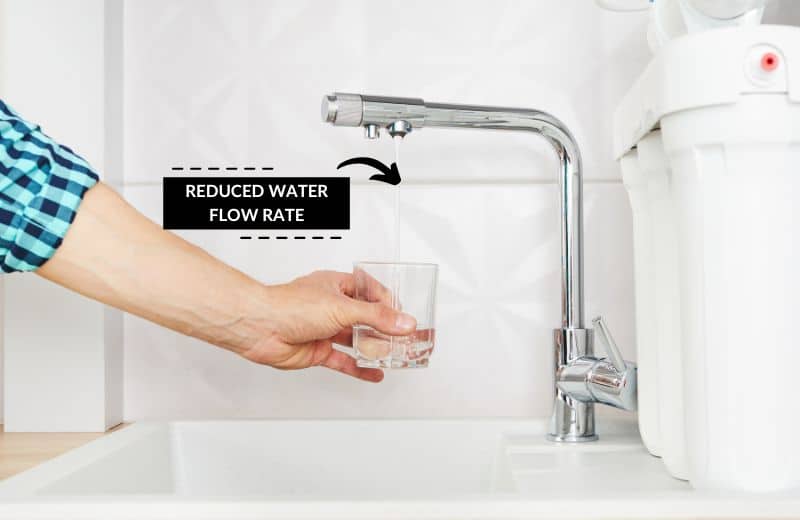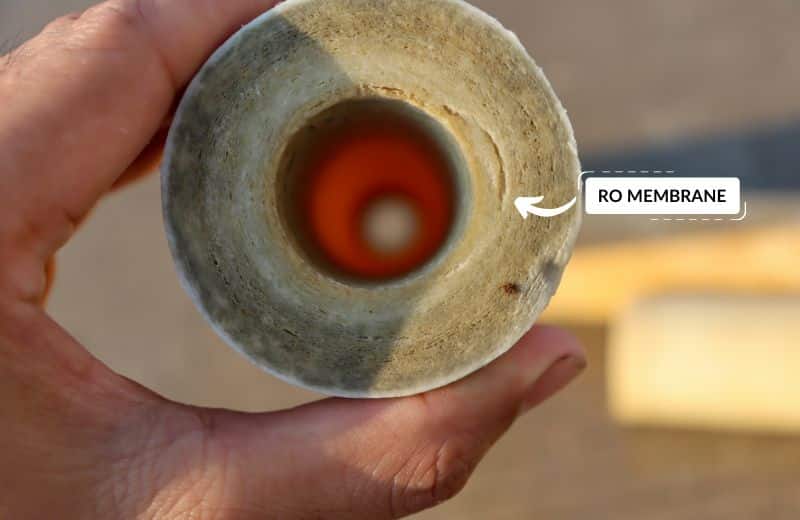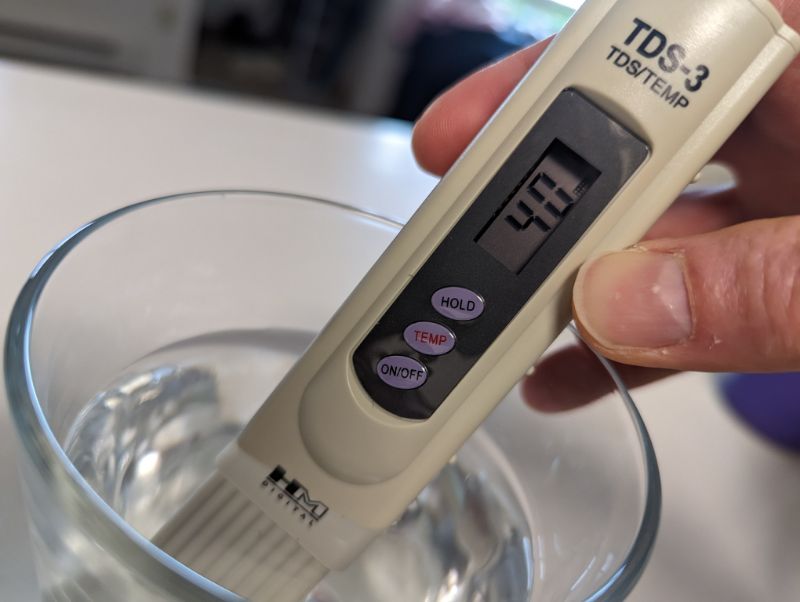The RO membrane in a reverse osmosis system lasts longer than the other filter stages, but it’ll still eventually need to be replaced.
In this guide, we’ve shared the 6 signs to look out for that suggest your RO membrane is bad.
📌 Key Takeaways
- The average lifespan of an RO membrane is 2 years.
- Reduced flow rate, poor water taste or smell, membrane discoloration or cloudiness, lukewarm water, and elevated TDS are all signs that the membrane needs to be replaced.
- Make sure the membrane specifically is bad, and not one of the other filters. Inspect the entire system and check the appearance of the other filters, too.
📋 6 Signs Your RO Membrane Is Bad
If you notice two or more of these signs, there’s a high chance that your reverse osmosis membrane is approaching the end of its lifespan.
1) Reduced Water Flow Rate
Reverse osmosis systems use thin-film membrane technology to repel contaminants – and the membrane’s tiny pores will eventually become clogged by impurities and restricted by fouling.
A clogged membrane will have a reduced capacity for allowing water molecules to pass through, reducing the flow of water out of the system and causing pressure to drop significantly below the feed water pressure.
On the other end, if you allow the membrane to degrade even more, your water pressure and flow might actually improve. This happens when holes form in the membrane surface, allowing untreated water to have free access straight through.
Note that low pressure could also be caused by low feed water pressure or problems with the RO tank pressure, so make sure to perform other reverse osmosis troubleshooting tasks, including checking the tank’s pressure gauge reading, if you’re not sure the membrane itself is to blame.

2) Poor Water Taste Or Smell
Purified water with a bad taste or smell is another sign that your RO membrane is bad. There are two reasons for this.
The first is normal contaminant accumulation in the membrane. Over time, sediment, dirt, and organic matter will build up on the membrane surface, resulting in a bad smell.
Poor odors from the membrane may carry over into the water molecules as they pass through the pores, causing your tap water to take on an unpleasant taste or smell.
The second reason for poor taste and odor is if parts of the delicate RO membrane break off, allowing accumulated contaminants to re-enter the water supply. This will only happen if you allow the membrane to become extremely degraded before you replace it.
3) Discolored Membrane
The next sign of a bad RO membrane is a visible sign that you’ll see by removing the membrane from its filter housing.
Brand-new reverse osmosis membranes are typically clear white in color. A worn, used membrane, on the other hand, will have a brown, gray, or orange tinge, caused by contaminants building up on the membrane surface.
You’ll know it’s time to replace your RO membrane if it’s noticeably a few shades darker than it was when you first installed it.

4) Cloudy Membrane
A cloudy membrane is another visible sign that the membrane is reaching the end of its lifespan.
Minerals in the feed water are largely responsible for cloudiness in the semi-permeable membrane. Over time, these minerals form limescale on the membrane surface, preventing water from getting through.
You’ll probably notice a drop in flow rate along with cloudiness of the membrane.
If your water’s mineral content is particularly high (hard water), you might need to install a water softener upstream of the RO filtration system to prevent early degradation of the membrane.
5) Lukewarm Water
The water from working RO water purifiers should be a normal temperature.
If your water is lukewarm or warm, it suggests elevated pressure inside the system is causing the water to get warmer than normal.
In this case, you know that membrane failure is likely imminent and it’s time to replace it with a new one.
6) Elevated TDS Levels
This final sign will require you to do a test of your water before and after your RO water purification system.
When you first installed your RO system, you hopefully conducted a similar test to check that the RO system was working properly.
You can repeat this test now to compare the total dissolved solids (TDS) levels in your purified water now compared to the TDS levels in your purified water originally.
For this test, you’ll need a TDS meter. A TDS meter is a digital device that’s used to measure the concentration of dissolved solids in water.
A good reverse osmosis system can reduce TDS levels to below 50 PPM (parts per million). It’s unlikely that your TDS reading will ever be 0, since the typical rejection of a reverse osmosis is 90-97%.
TDS levels up to 150 PPM are adequate in drinking water, but if your water’s TDS levels are reading higher than this, it suggests that the membrane is no longer doing its job and should be replaced.

🤔 Membrane Or Other Filter Stages?
Remember that RO systems have numerous filter stages, and signs like reduced water flow and changes to your water quality may also be caused by a clogged sediment filter or degraded activated carbon filter.
That’s why it’s a good idea to note down the various filter lifespans in your RO system and do a visible check-over of each filter stage once it nears the end of its expected lifespan. You don’t want to spend money on a new membrane if only the carbon filter or sediment filter needs replacing, after all.
📑 Final Word
RO membranes are highly effective at removing up to 99% of all total dissolved solids – but only when they’re working properly.
Make sure to replace the membrane in your RO water filter at least once every 2 years, unless your user manual instructs otherwise.
This will prevent degradation of the membrane that will affect its ability to remove contaminants and reduce its efficiency.
You can buy replacement membranes online, either directly from the manufacturer or on marketplaces like Amazon.
Related: How long do RO membranes last?
